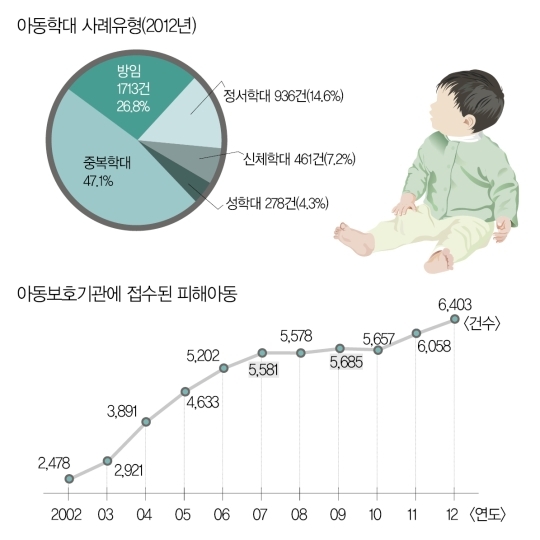Can''t force reformation programs on perpetrators
Emotional abuse is tough to detect and report
An "Act on Special Cases concerning Child Abuse" that includes stronger punishment and protection measures must pass the Nat''l Assembly this time.

Family is, or should be, the safest place in the world for a child. However, more and more children are abused and even lose their lives by their family members these days, which prompted many to call for an improvement on laws and regulations against child abuse. The general public's opinion is that although we could have been able to prevent the recent tragic incidents had we been vigilant enough, it is still "better late than never."
An 8-year-old girl who died after her step-mother beat her and broke 16 ribs. Another 8-year-old boy who was also beaten to death by his parents. A 17-month-old infant in Wonju-si, Kangwon-do, who was hemiparalized because of the abuse and violence of the babysitter. All these horrendous incidents are only some of the child abuse cases happening in our society, so many of which often go unnoticed. According to child protection and advocacy groups nationwide, the number of child abuse incidents almost quadrupled during the past 10 years, from 2,478 in 2002 to 8,979 last year. 86 children were lost to abuse during the same period.
More cases are being reported or uncovered these days, but many criticize that the poorly built and managed current legal system is not enough to cut down the rate of child abuse.
First of all, although child abuse offenders are mandated to participate in counseling and educational programs provided by child protection organizations, but there isn't a way to force offenders to sit in or punish them for not complying, since these organizations that handle child abuse reports and provide education programs are private ones and not armed with public authority. Hong Chang-pyo, a public relations manager at the National Child Protection Agency said "education programs and counseling are the immediate tools available to prevent such incidents, but we can't force the perpetrators to take the programs unless they voluntarily come to take part in, since we do not have the right."
Another problem is that even if a child protection organization sees an individual case as an abuse incident, it is difficult to follow through with the case until the offender receives due punishment. According to the Ministry of Health and Welfare's 2012 report on child abuse, the offenders of only 6.6% (420) out of the entire (8,979) cases were reported or accused by an organization. 77.8%, or 4,938 cases, the absolute majority of all, were ordered for a continued observation, and only 5.7% or 365 cases were led to the separation between the offenders and children. This is largely because of the difficulties facing the reporting and accusation procedure, as it is hard to secure evidence especially if an abuse is emotional rather than physical, and many of the evidence has to be collected based on the children's statement.
The relevant legal clauses being scattered around in "Child Welfare Act," "Act on the Prevention of Domestic Violence and Protection, etc. of Victims," and "Criminal Act" makes the situation even worse. The U.S. and Japan both have an act deals specifically with child abuse crimes, for which the maximum sentence is life imprisonment.
As part of the effort to solve the problem, the "Act on Special Cases concerning Child Abuse" is currently pending in the National Assembly. However, the previously submitted bills by Saenuri party's Jeong Woo-taek ("Bill on the Prevention of Child Abuse and the Protection and Care for Child Victims"). Saenuri's Ahn Hong-joon ("Special Bill on the Punishment Against Child Abuse"), and Democratic party's Nam Yoon In-soon ("Bill on the Prevention of Child Abuse and the Protection for Victims") have been waiting to be reviewed for over an year.
According to prof. Jeong Woong-seok at Seokyung Univ., "victims of child abuse crimes are usually treated based on Child Welfare Act, while the offenders are dealt with based on the laws on domestic violence or crime." Therefore, he added. "we need a comprehensive special law in place to handle the criminal matters regarding the offenders and the protection of the child victims."

